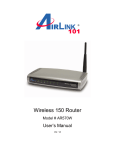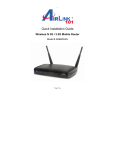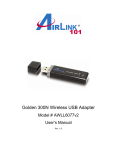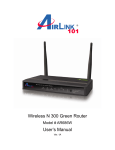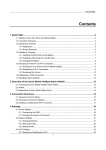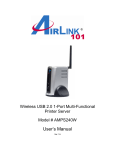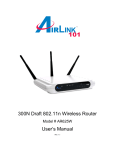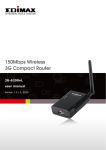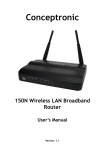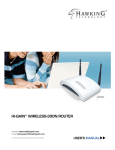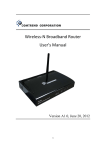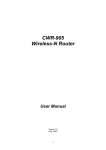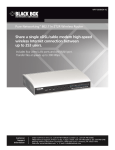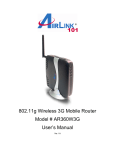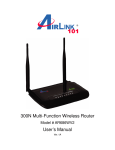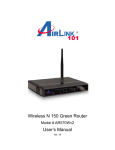Download Wireless N 3G/3.5G Mobile Router User`s Manual
Transcript
Wireless N 3G/3.5G Mobile Router Model # AR660W3G User’s Manual Ver. 1A Federal Communication Commission Interference Statement FCC Part 15 This equipment has been tested and found to comply with the limits for a Class B digital device, pursuant to Part 15 of FCC Rules. These limits are designed to provide reasonable protection against harmful interference in a residential installation. This equipment generates, uses, and can radiate radio frequency energy and, if not installed and used in accordance with the instructions, may cause harmful interference to radio communications. However, there is no guarantee that interference will not occur in a particular installation. If this equipment does cause harmful interference to radio or television reception, which can be determined by turning the equipment off and on, the user is encouraged to try to correct the interference by one or more of the following measures: 1. Reorient or relocate the receiving antenna. 2. Increase the separation between the equipment and receiver. 3. Connect the equipment into an outlet on a circuit different from that to which the receiver is connected. 4. Consult the dealer or an experienced radio technician for help. FCC Caution This equipment must be installed and operated in accordance with provided instructions and a minimum 20 cm spacing must be provided between computer mounted antenna and person’s body (excluding extremities of hands, wrist and feet) during wireless modes of operation. This device complies with Part 15 of the FCC Rules. Operation is subject to the following two conditions: (1) this device may not cause harmful interference, and (2) this device must accept any interference received, including interference that may cause undesired operation. Any changes or modifications not expressly approved by the party responsible for compliance could void the authority to operate equipment. Federal Communication Commission (FCC) Radiation Exposure Statement This equipment complies with FCC radiation exposure set forth for an uncontrolled environment. In order to avoid the possibility of exceeding the FCC radio frequency exposure limits, human proximity to the antenna shall not be less than 20cm (8 inches) during normal operation. The antenna(s) used for this transmitter must not be co-located or operating in conjunction with any other antenna or transmitter. The equipment version marketed in US is restricted to usage of the channels 1-11 only. Table of Contents FEDERAL COMMUNICATION COMMISSION INTERFERENCE STATEMENT ......................... 2 TABLE OF CONTENTS ............................................................................................................... 3 CHAPTER 1 INTRODUCTION ..................................................................................................... 6 1.1 FEATURES ...................................................................................................................................6 1.2 PACKAGE CONTENTS ...................................................................................................................6 1.3 ROUTER INTERFACE ....................................................................................................................6 CHAPTER 2 CONNECTING THE ROUTER................................................................................. 9 2.1 BUILDING NETWORK CONNECTION ...............................................................................................9 2.2 CONFIGURING THE ROUTER – SETUP WIZARD ............................................................................10 2.3 CONNECTING TO THE ROUTER WIRELESSLY ...............................................................................23 2.4 TROUBLESHOOTING ...................................................................................................................26 CHAPTER 3 USING WEB CONFIGURATION UTILITY............................................................. 28 3.1 NETWORK .................................................................................................................................29 3.1.1 WAN ............................................................................................................................. 29 3.1.2 3G/3.5G ........................................................................................................................ 29 3.1.3 LAN............................................................................................................................... 30 3.1.4 DNS .............................................................................................................................. 33 3.1.5 DDNS............................................................................................................................ 34 3.1.6 NAT............................................................................................................................... 35 3.2 WIRELESS .................................................................................................................................36 3.2.1 Basic Settings ............................................................................................................... 36 3.2.2 Wireless Security.......................................................................................................... 37 3.2.2.1 WEP........................................................................................................................... 38 3.2.2.2 WPA Pre-share Key .................................................................................................. 39 3.2.2.3 WPA RADIUS............................................................................................................ 40 3.2.3 MAC Control ................................................................................................................. 41 3.2.4 Advanced Settings........................................................................................................ 42 3.2.5 WPS.............................................................................................................................. 44 3.3 APPLICATION & GAMING ............................................................................................................48 3.3.1 Port Forwarding ............................................................................................................ 48 3.3.2 Port Triggering .............................................................................................................. 49 3.3.3 DMZ .............................................................................................................................. 51 3.3.4 ALG Settings................................................................................................................. 53 3.3.5 QoS............................................................................................................................... 54 3.4 ACCESS RESTRICTIONS .............................................................................................................58 3.4.1 Access Control.............................................................................................................. 58 3.4.1.1 MAC Filtering............................................................................................................. 59 3.4.1.2 IP Filtering.................................................................................................................. 60 3.4.2 URL Filtering................................................................................................................. 62 3.5 SECURITY ..................................................................................................................................64 3.5.1 Firewall ......................................................................................................................... 64 3.5.2 VPN Pass through ........................................................................................................ 64 3.5.3 DoS (Denial-of-Service)................................................................................................ 65 3.6 ADMINISTRATION .......................................................................................................................66 3.6.1 Time.............................................................................................................................. 66 3.6.2 Password ...................................................................................................................... 67 3.6.3 Remote Management ................................................................................................... 68 3.6.4 Firmware Upgrade........................................................................................................ 69 3.6.5 System Settings............................................................................................................ 70 3.6.6 Reboot .......................................................................................................................... 70 3.6.7 System Log................................................................................................................... 71 3.6.8 Security Log.................................................................................................................. 71 3.6.9 Statistics ....................................................................................................................... 72 3.6.10 UPnP .......................................................................................................................... 73 3.7 STATUS .....................................................................................................................................74 3.7.1 Internet Connection Status ........................................................................................... 74 3.7.2 LAN Status.................................................................................................................... 74 3.7.3 Wireless Status............................................................................................................. 75 3.7.4 System Status............................................................................................................... 75 3.7.5 Modem Info................................................................................................................... 75 TECHNICAL SUPPORT ............................................................................................................. 77 Chapter 1 Introduction Congratulations on your purchase of AR660W3G Wireless N 3G/3.5G Mobile Router. This product is specifically designed for business travelers or SOHO needs. It provides an extended WAN solution, 3G Mobile USB modem card for Internet surfing besides regular Cable or DSL modem and is easy to share the Internet connectivity wherever 3G mobile Internet service is available. It is recommended to use with AirLink101® Wireless N products to provide the best performance. The high speed of up to 300Mbps* combined with extended wireless coverage delivers fast and reliable connections for all of your networking applications. A full range of security features such as WEP, WPA-PSK, and WPA2-PSK provide the highest level of wireless network security. The web-based Setup Wizard allows you to set up the router with an easy-to-use user interface. Meanwhile, the AR660W3G works with 802.11n / g / b network devices which ensures compatibility with your existing wireless products. 1.1 Features • • • • • • • • • • Share Broadband Internet connection from either your 3G USB Modem or Cable/DSL Industry’s highest wireless data rate of up to 300Mbps* with 802.11n draft 2.0 Built-in four LAN ports (10/100M) and one WAN port (10/100M) Supports UMTS/HSDPA/EVDO 3G/3.5G USB modem Two 3dBi external antennas for wider coverage and stronger signal strength to eliminate dead spots 64-bit/128-bit WEP encryption, Pre-shared Key (PSK), and Wi-Fi Protected Access (WPA2 and WPA) support provide full protection for your wireless connection Stronger signal strength increases the reliability and speed of wireless connections Great for environments with higher wireless data traffic requirements Fully backward-compatible with 802.11b/g devices Works best with AirLink101® Wireless N and 300N Adapters 1.2 Package Contents Before you start to use this router, please check if there’s anything missing in the package, and contact your dealer of purchase to claim for missing items: • Wireless N 3G/3.5G Mobile Router • Quick installation guide • Manual CD • A/C power adapter • Ethernet Cable 1.3 Router Interface Front Panel LEDs 6 LED Light Status Description POWER On Router is powered on. On WPS setup is in progress. Off Wireless network is switched off. Flashing Wireless network is ready and WPS setup is not in progress. On WAN port is connected. Off WAN port is not connected. Flashing WAN port is transferring or receiving data. On USB modem is connected Off USB modem is not connected Flashing USB modem is transferring or receiving data. On LAN port is connected. Off LAN port is not connected. Flashing LAN port is transferring or receiving data. WLAN WAN LNK/ACT USB LNK/ACT LAN 1-4 LNK/ACT Back Panel Antenna B Antenna A 7 Item Name Description Antenna A/B These antennas are 3dBi dipole antennas. Radio ON/OFF Switch the button to activate or deactivate the Router’s wireless function. Reset / WPS Reset the router to factory default settings (clear all settings) or start security synchronization function (WPS). Press this button and hold for 10 seconds to restore all settings to factory defaults. Press this button for no longer than 1 second to start security synchronization. 1-4 Local Area Network (LAN) ports 1 to 4. WAN Wide Area Network (WAN / Internet) port. Power Power connector, connects to A/C power adapter. 8 Chapter 2 Connecting the Router 2.1 Building Network Connection Note: Prior to connecting the router, be sure to power off your computer, DSL/Cable modem(if applicable), and the router. Step 1 Option 1 Plug the 3G/3.5G USB modem into the USB slot on the front panel of the router. 3G USB Modem Option 2 Connect one end of a network cable to the WAN port of the router and connect the other end of the cable to the DSL/Cable modem. Power on the modem. Cable/DSL Modem Step 2 With another network cable, connect one end of the cable to your computer’s Ethernet port and connect the other end to one of the LAN ports of the router. (After setup finishes, you can remove the network cable between the computer and router if you want to use wireless connection.) 9 Step 3 Plug the power adapter to the router and connect it to an outlet or power strip. Step 4 Power on your computer. Step 5 Make sure the Power, WAN or USB, WLAN, and the LAN port that the computer is connected to are lit. If not, try the above steps again. 2.2 Configuring the Router – Setup Wizard Step 1 Open the web browser (i.e. Internet Explorer or Mozilla Firefox) and type 192.168.2.1 in the URL address bar and press Enter. Step 2 Enter admin for both the user name and password and click OK. 10 Step 3 Click on Setup Wizard. Step 4 Configure the Time Zone Settings of the Router. Click Next. 11 The Time Zone allows your router to base its time on the settings configured here, this will affect functions such as Log entries and Firewall settings. Parameter Description Time Zone You can select your local time zone here. The router will sync time according to your time zone selection. Time Server Address Input the IP address / host name of time server here Daylight Saving If the country you live uses daylight saving, please check the Enable box and choose the duration of daylight saving. Step 5 Please choose the broadband (Internet connection) type you are using in this page. If you’re not sure, please contact your Internet service provider. A wrong Internet connection type will cause connection problem, and you may not be able to connect to internet. 12 3G/3.5G Click on 3G/3.5G if you are connecting to Internet through a 3G USB modem. When the 3G/3.5G detailed settings come up, enter the Internet connection parameters if it is required by your wireless 3G Internet Service Provider and then click NEXT. Note: The setting shown above is for Verizon Wireless USB720 Modem. Parameter Description 13 PIN Code Please input Pin Code for your UMTS or HSDPA or EVDO connection, this is optional, and only required if your service provider asks you to do so. APN Please input the APN code assigned by your Internet service provider here. User Name Please input user name assigned by your Internet service provider here. Password Please input password assigned by your Internet service provider here. Verify Password Please input password again for confirmation. Service Please select your service type between CDMA2000 or 3G/3.5G Only. You may try both service types if you are not sure which one your USB modem card uses. AT Dial Script Please input Dialed Number for your UMTS or HSDPA connection, the default is *99#. This field should not be altered except when required by your service provider. Cable Click on Cable Modem if you are connecting to Internet through a cable modem. When the Dynamic IP settings come up, click “Clone MAC” button and click NEXT. Parameter Description Host Name Please input the host name of your computer, this is optional, and only required if your service provider asks you to do so. MAC Address Please input MAC address of your computer here, if your service provider only permits computer with certain MAC address to access internet. If you are using the computer which used to connect to Internet via cable modem, you can simply press “Clone Mac address” button to fill the MAC address field with the MAC address of your computer. 14 DSL For DSL users, your Internet type is either Dynamic IP or PPPoE. If you are not sure which one you have, it is suggested to select PPPoE xDSL for your WAN type, and if you cannot connect to the Internet after the Setup Wizard finished, go through the Setup Wizard again and select Cable Modem. Otherwise, you can call your ISP to confirm which Internet type you have. Option 1: PPPoE Settings Click on PPPoE xDSL for your WAN type. Enter your user name and password provided by your ISP. Click NEXT. Note: Depending on the ISP, you may need to include the domain name with your username. Example: [email protected] Parameter Description User Name Please input user name assigned by your Internet service provider here. Password Please input the password assigned by your Internet service provider here. Service Name Please give a name to this Internet service (this is optional). MTU Please input the MTU value of your network connection here. If you don’t know, you can use default value. Connection Type Please select the connection type you wish to use. There are 3 options: 1) ‘Continuous’ - keep internet connection alive, do not disconnect, 15 2) “Connect on Demand” - only connects to Internet when there’s a connect attempt. 3) ‘Manual’ - only connects to Internet when ‘Connect’ button on this page is pressed, and disconnects when ‘Disconnect button is pressed. Idle Time Out Specify the time to shutdown internet connect after no internet activity is detected by minute. This option is only available when connection type is ‘Connect on Demand’. Option 2: Dynamic IP Settings Click on Cable Modem for your WAN type. When the Dynamic IP settings come up, leave the settings as default and click NEXT. Fixed IP Click on Fixed-IP xDSL if your ISP (Internet Service Provider) has provided you a set of IP addresses for your Internet connection. Enter the IP address, Subnet Mask and Default Gateway provided by your ISP. Note: You must use the addresses provided by your Internet service provider, wrong setting value will cause connection problem. 16 PPTP PPTP xDSL requires two kinds of setting: WAN interface setting (setup IP address) and PPTP setting (PPTP user name and password). Here we start from WAN interface setting: Select the type of how you obtain IP address from your service provider here. You can choose “Obtain an IP address automatically” (equal to DHCP, please refer to „Cable Modem section above), or “Use the following IP address” (i.e. static IP address). WAN interface settings must be correctly set, or the Internet connection will fail even those settings of PPTP settings are correct. Please contact your Internet service provider if you don’t know what you should fill in these fields. Now please go to PPTP settings section: Parameter Description User Name Please input user name assigned by your Internet service provider here. Password Please input the password assigned by your Internet service provider here. 17 PPTP Gateway Please input the IP address of PPTP gateway assigned by your Internet service provider here. Connection ID Please input the connection ID here, this is optional and you can leave it blank. MTU Please input the MTU value of your network connection here. If you don’t know, you can use default value. BEZEQ-ISRAEL Setting item BEZEQ-ISRAEL is only required to check if you’re using the service provided by BEZEQ network in Israel. Connection Type Please select the connection type of Internet connection you wish to use, please refer to last section for detailed descriptions. Idle Time Out Please input the idle time out of Internet connection you wish to use, and refer to last section for detailed descriptions. When you finish with all settings, please click NEXT. L2TP L2TP is another connection method for xDSL and other Internet connection types, and all required setting items are the same with PPTP connection. Like PPTP, there are two kinds of required setting, we will start from “WAN Interface Settings”: Select the type of how you obtain IP address from your service provider here. You can choose “Obtain an IP address automatically” (equal to DHCP, please refer to „Cable Modem section above), or “Use the following IP address” (i.e. static IP address). WAN interface settings must be correctly set, or the Internet connection will fail even those settings of L2TP settings are correct. Please contact your Internet service provider if you don’t know what you should fill in these fields. Now please go to L2TP settings section: 18 Parameter Description User Name Please input user name assigned by your Internet service provider here. Password Please input the password assigned by your Internet service provider here. L2TP Gateway Please input the IP address of L2TP gateway assigned by your Internet service provider here. MTU Please input the MTU value of your network connection here. If you don’t know, you can use default value. Connection Type Please select the connection type of Internet connection you wish to use, please refer to last section for detailed descriptions. Idle Time Out Please input the idle time out of Internet connection you wish to use, and refer to last section for detailed descriptions. When you finish with all settings, please click NEXT. Telstra Big Pond This setting only works when you are using Telstra Big Pond’s network service in Australia. You need to input: Parameter Description User Name Please input user name assigned by Telstra. Password Please input the password assigned by Telstra. 19 Assign login server manually Check this box to choose login server by yourself. Server IP Address Please input the IP address of login server here. When you finish with all settings, please click NEXT. Step 6 Keep the default SSID (wireless network name) or change it to a desired name, so you can always recognize your wireless network with it. Click Next. Parameter Description Band Please select the radio band from one of the following options. 2.4GHz (B): 2.4GHz band, only allows 802.11b wireless network client to connect to this router (maximum transfer rate 11Mbps). 2.4 GHz (N): 2.4GHz band, only allows 802.11n wireless network client to connect to this router (maximum transfer rate 300Mbps). 2.4 GHz (B+G):2.4GHz band, only allows 802.11b and 802.11g wireless network client to connect to this router (maximum transfer rate 11Mbps for 802.11b clients, and maximum 54Mbps for 802.11g clients). 2.4 GHz (G): 2.4GHz band, only allows 802.11g wireless network client to connect to this router (maximum transfer rate 54Mbps). 2.4 GHz (B+G+N): 2.4GHz band, allows 802.11b, 802.11g, and 802.11n wireless network client to connect this router (maximum transfer rate 11Mbps for 802.11b clients, maximum 54Mbps for 802.11g clients, and maximum 300Mbps for 802.11n clients). SSID This is the name of the wireless network. You can type any alphanumerical characters here, maximum 32 characters. SSID is used to identify your own wireless router from others when there are other wireless routers in the same area. The default SSID is ‘airlink101’; it’s recommended to change it to a name that you can identify, such as myhome, office_room1, etc. 20 Channel Number Select a channel from the dropdown list of ‘Channel Number’ for broadcasting. You can choose any channel number you want to use, and almost all wireless clients can locate the channel you’re using automatically without any problem. However, it’s still useful to remember the channel number you use, some wireless client supports manual channel number selecting, and this would help in certain scenario when there is some radio communication problem. Associated Clients Click “Show Active Clients” button, then an “Active Wireless Client Table” will pop up. You can see the status of all active wireless stations that are connecting to the access point. Step 7 Select a desired Security Mode from the drop-down menu. WPA2(AES) is the most secured encryption mode for general users. WEP is the most common encryption but the least secured. It is recommended to use WPA2 (AES) for your wireless security if all wireless devices on your network can support this mode. WPA2(AES) Select WPA pre-shared key for Encryption. Enter the settings below: • • • WPA Unicast Cipher Suite: Select WPA2(AES) Pre-Shared Key Format: Select Passphrase Pre-shared Key: Enter a key between 8 to 63 characters (alphanumeric, case sensitive). This is the security key for your wireless network 21 Click OK to save the settings. WEP Enter the settings below: • • • • Key Length: Select 64-bit or 128-bit Key Format: Select ASCII or Hex Default Tx Key: Select Key 1 Encryption Key 1: If you selected 64-bit key length and ASCII key format, enter 5 alphanumeric characters. If you selected 128-bit key length and ASCII key format, enter 13 alphanumeric characters. If you selected 64-bit key length and HEX key format, enter 10 hexadecimal characters (0~9, A~F) for Key Setting. If you selected 128-bit key length and HEX key format, enter 26 hexadecimal characters. This is the security key for your wireless network. Click on OK to save and activate all the settings. Now, you can start to use the router as your internet gateway. Note: It is suggested to write down the security settings (Encryption and Key) you configured for the Router on a piece of paper and keep it in a safe place. Step 8 Click Apply to restart the router. 22 After 30 seconds, you will go back to the Status page with valid IP address assigned by you ISP (or configured by yourself if you use Static IP) in either WAN or 3G/3.5G Status section. If either section has valid IP addresses assigned, the router is connected to the Internet. Congratulations! Your router configuration has been finished. You should now be able to access the Internet; if not, please go to section 2.4 for troubleshooting. 2.3 Connecting to the Router Wirelessly You must configure your wireless computer in order to establish a wireless connection to the router. In this section, you can find the instructions of how to connect to the router wirelessly with your Vista computer. You can also refer to the manual of your wireless network card regarding how to connect to a router wirelessly. Step 1 Click on this icon are available. on the task bar of your desktop, then click on Wireless networks Step 2 Select the wireless network you want to connect to and click Connect. 23 Step 3 Enter the Security key you configured for the Router (see Step 8 in Section 2). Click Connect. Step 4 Click on Close. Now the wireless connection has been established successfully with the Router. 24 25 2.4 Troubleshooting If you have trouble connecting to the Internet with Cable/DSL modem, try the following steps: Step 1 Power off the Cable/DSL modem, router, and computer and wait for 5 minutes. Step 2 Turn on the Cable/DSL modem and wait for the lights on the modem to settle down. Step 3 Turn on the router and wait for the lights on the router to settle down. Step 4 Turn on the computer. Step 5 Log in to the router and you will see the Internet Connection Status. Step 6 Verify that the Internet IP Address, Subnet Mask, and Default Gateway under WAN Status section have valid numbers assigned to them (instead of all 0’s). If you have trouble connecting to the Internet with 3G/3.5G USB modem, there are few things your can try: 1. Make sure your 3G/3.5G modem is compatible with AR660W3G Wireless N 3G/3.5G Router. Please check the compatibility list at www.airlink101.com. 2. Make sure the 3G/3.5G USB modem works when it is directly connected to your computer 3. Make sure the 3G/3.5G USB modem is properly connected to the Router. The LED indicator on the USB modem should be lit up. 4. Double check the 3G/3.5G modem settings you configured for the Router, and make sure all settings are correct. 5. Verify that the Internet IP Address, Subnet Mask, and Default Gateway under 3G/3.5G Status section have valid numbers assigned to them (instead of all 0’s). 26 27 Chapter 3 Using Web Configuration Utility The Web Configuration Utility contains advanced features that allow you to configure the router to meet your network’s needs such as: Access Control, QoS (Quality of Service), Port Forwarding (Virtual Server) and other functions. If you have already configured the Setup Wizard, you do NOT need to configure any other thing here for you to start using the Internet. Below is a general description of the advanced functions available for this router. Menu Description 3.0 Setup Wizard This quick setup wizard can guide you through the basic settings of this Router. Please see instructions in Chapter 2.2. 3.1 Network This section allows you to configure the Internet, 3G/3.5G settings with your ISP, the settings of your local area network (LAN), such as enable/disable the DHCP server, Dynamic DNS information, and NAT function. 3.2 Wireless This section allows you to setup the Router’s SSID, security key, WPS, etc. 3.3 Application & Gaming This section allows you to configure router’s setting for your special applications or gaming requirements, such as open certain ports for your applications. 3.4 Access Restrictions This section allows you to set up the access control rules, such as MAC filtering, URL filtering to prevent the LAN users from accessing certain type of website. 3.5 Security This Firewall section allows you to configure Hacker Prevention and VPN pass through. 3.6 Administration The section allows you to specify a time zone, change the system password, save/reload the router configuration, upgrade firmware and so on. 3.7 Status You can see Router’s status in this section. 28 3.1 Network 3.1.1 WAN Use the WAN setting page to change your Internet connection type. The WAN setting page allows you to configure the Internet connection type of your ISP. The WAN settings offer the following selections for the router’s WAN port, Dynamic IP, Static IP, PPPoE, PPTP, L2TP and Telstra Big Pond. Please choose one type and complete the detail settings below. Please see Chapter 2.2, Step 5 for the detailed description of each WAN type. 3.1.2 3G/3.5G Configure the 3G/3.5G settings if you like to connect to the Broadband Internet with your 3G/3.5G USB Modem. 29 Note: The setting shown above is for Verizon 720 USB Modem. Parameter Description PIN Code Please input Pin Code for your UMTS or HSDPA or EVDO connection, this is optional, and only required if your service provider asks you to do so. APN Please input the APN code assigned by your Internet service provider here. User Name Please input user name assigned by your Internet service provider here. Password Please input password assigned by your Internet service provider here. Verify Password Please input password again for confirmation. Service Please select your service type between CDMA2000 or 3G/3.5G Only. You may try both service types if you are not sure which one your USB modem card uses. AT Dial Script Please input Dialed Number for your UMTS or HSDPA connection, the default is *99#. This field should not be altered except when required by your service provider. 3.1.3 LAN This page allows you to specify an IP address for your router, configure the DHCP Server and Static DHCP Lease Table. 30 ¾ LAN IP section Parameters Default IP address Subnet Mask 192.168.2.1 255.255.255.0 Description This is the router’s LAN IP address (Your LAN clients default gateway IP address). Specify a Subnet Mask for your LAN segment. 802.1d Spanning Tree Disable If you wish to activate 802.1d spanning tree function, select “Enabled”, or set it to “Disabled” If 802.1d Spanning Tree function is enabled, this router will use the spanning tree protocol to prevent from network loop happened in the LAN ports. DHCP Server Enable By enablting the DHCP server, the router will automatically give your LAN clients an IP address. If the DHCP server is not enabled then you’ll have to manually set your LAN client’s IP addresses; make sure the LAN Client is in the same subnet as this broadband router if you want the router to be your LAN client’s default gateway. ¾ DHCP Server section Parameters Description Lease Time Please choose a lease time (the duration that every computer can keep a specific IP address) of every IP address assigned by this router from dropdown menu. Start IP Please input the start IP address of the IP range. End IP Please input the end IP address of the IP range. Domain Name (4): If you wish, you can also optionally input the domain name for your network. This is optional. DHCP Client Range You can configure a particular IP address range for your DHCP server to assign IP addresses to your LAN Clients. Note: By default the IP range is from: Start IP 192.168.2.100 to End IP 192.168.2.200. If you want your PC to have a static/fixed IP address then you’ll have to choose an IP address outside this IP address range. Static DHCP Specify the Static DHCP Addresses for your LAN clients. Domain Name Enter the domain name of your LAN interface if there is one. 31 ¾ Static DHCP Lease Table section This function allows you to assign a static IP address to a specific computer forever, so you don’t have to set the IP address for a computer, and still enjoy the benefit of using DHCP server. Maximum 16 static IP addresses can be assigned here. (If you set “Lease Time” to forever in DHCP Server section, you can assign an IP address to a specific computer permanently). Parameters Description Enable Static DHCP Leases Check this box to enable this function, otherwise DHCP uncheck it to disable this function. MAC Address Input the MAC address of the computer or network device (total 12 characters, with character from 0 to 9, and from a to f, like “00:11:22:aa:bb:cc”) IP address Input the IP address you want to assign to this computer or network device Add After you entered MAC address and IP address pair, click this button to add the pair to static DHCP leases table. After you clicked “Add”, the MAC address and IP address mapping will be added to “Static DHCP Lease Table” section. If you want to delete a specific item, please check the “Select” box of a MAC address and IP address mapping, then click “Delete” button. If you want to delete all mappings, click “Delete All”. After you finish with all settings, please click “Apply” button. If you want to reset all settings in this page, please click “Cancel” button. 32 After you clicked Apply, the following message will be displayed on your web browser: You can click “Continue” to back to previous setup page to continue on other setup procedures, or click “Apply” to reboot the router so the settings will take effect (Please wait for about 30 seconds while router is rebooting). 3.1.4 DNS If you select Dynamic IP or PPPoE as Internet connection method, at least one DNS server’s IP address should be assigned automatically. However, if you have preferred DNS server, or your service provider didn’t assign the IP address of DNS server because of any reason, you can input the IP address of DNS server here. Parameter Description Primary DNS Please input the IP address of DNS server provided by your service provider. Secondary DNS Please input the IP address of another DNS server provided by your service provider, this is optional. After you finish with all settings, please click “Apply” button. If you want to reset all settings in this page, please click “Cancel” button. After you clicked Apply, the following message will be displayed on your web browser: 33 You can click “Continue” to back to previous setup page to continue on other setup procedures, or click “Apply” to reboot the router so the settings will take effect (Please wait for about 30 seconds while router is rebooting). 3.1.5 DDNS DDNS allows you to map the static domain name to a dynamic IP address. You must get an account, password and a static domain name from a DDNS service provider. This router supports DynDNS (www.dyndns.org), and TZO (www.tzo.com). Parameters Dynamic DNS Default Disable Description Enable/Disable the DDNS function of this router. Provider Select a DDNS service provider. Domain name Your static domain name that use DDNS. Account The account/username that your DDNS service provider assigned to you. Password/Key The password you set for the DDNS service account above. After you finish with all settings, please click “Apply” button. If you want to reset all settings in this page, please click “Cancel” button. 34 After you clicked Apply, the following message will be displayed on your web browser: You can click “Continue” to back to previous setup page to continue on other setup procedures, or click “Apply” to reboot the router so the settings will take effect (Please wait for about 30 seconds while router is rebooting). 3.1.6 NAT Network address translations solve the problem if sharing a single IP address to multiple computers. Without NAT, all computers must be assigned with a valid public IP address to get connected to Internet, but Internet service providers only provide very few IP addresses to every user. Therefore it’s necessary to use NAT technology to share a single Internet IP address to multiple computers on local network, so everyone can get connected to Internet. Please follow the following instructions to set NAT parameters: The NAT function is enabled by default; to disable, please select “Disable”. Do not disable NAT unless you have professional knowledge on routing. After you finish with all settings, please click “Apply” button. If you want to reset all settings in this page, please click “Cancel” button. After you clicked Apply, the following message will be displayed on your web browser: 35 You can click “Continue” to back to previous setup page to continue on other setup procedures, or click “Apply” to reboot the router so the settings will take effect (Please wait for about 30 seconds while router is rebooting). 3.2 Wireless 3.2.1 Basic Settings You can set parameters that are used for wireless clients to connect to this router. The parameters include SSID, Channel Number, etc. Parameters Band Default 2.4 GHz (B+G+N) Description Please select the radio band from one of the following options. 2.4GHz(B): 2.4GHz band, only allows 802.11b wireless network client to connect this router (maximum transfer rate 11Mbps*). 2.4 GHz (N): 2.4GHz band, only allows 802.11n wireless network client to connect this router (maximum transfer rate 300Mbps*). 2.4 GHz (B+G):2.4GHz band, only allows 802.11b and 802.11g wireless network client to connect this router (maximum transfer rate 11Mbps for 802.11b clients, and maximum 54Mbps for 802.11g clients*). 2.4 GHz (G): 2.4GHz band, only allows 802.11g wireless network client to connect this router (maximum transfer rate 54Mbps*). 2.4 GHz (B+G+N): 2.4GHz band, allows 802.11b, 802.11g, and 802.11n wireless network client to connect this router (maximum transfer rate 11Mbps for 802.11b 36 clients, maximum 54Mbps for 802.11g clients, and maximum 300Mbps for 802.11n clients*). SSID Channel Number airlink101 This is the name of your wireless network. You can type any alphanumerical characters here, maximum 32 characters. SSID is used to identify your own wireless router from others when there are other wireless routers in the same area. It’s recommended to change default SSID value to the one which is meaningful to you, like myhome, office_room1, etc. 6 Please select a channel from the dropdown list of ‘Channel Number’ for broadcasting. You can choose any channel number you want to use, and almost all wireless clients can locate the channel you’re using automatically without any problem. However, it’s still useful to remember the channel number you use, some wireless client supports manual channel number select, and this would help in certain scenario when there is some radio communication problem. Show Active Clients Click “Show Active Clients” button, then an “Active Wireless Client Table” will pop up. You can see the status of all active wireless clients that are connecting to the Router. After you finish with all settings, please click “Apply” button. If you want to reset all settings in this page, please click “Cancel” button. After you clicked Apply, the following message will be displayed on your web browser: You can click “Continue” to back to previous setup page to continue on other setup procedures, or click “Apply” to reboot the router so the settings will take effect (Please wait for about 30 seconds while router is rebooting). 3.2.2 Wireless Security The AR660W3G provides complete wireless LAN security functions, including WEP, IEEE 802.11x, WPA2/WPA-PSK and WPA with RADIUS. With these security functions, you can prevent your wireless LAN from illegal access. Please make sure your wireless clients use the same security settings. 37 Parameters Default Description Encryption You can choose Disable, WEP, WPA pre-share key, WPA RADIUS for encryption mode. Enable 802.1x Authentication IEEE 802.1x is an authentication protocol. Every user must use a valid account to login to this Access Point before accessing the wireless LAN. The authentication is processed by a RADIUS server. Check this box to authenticates user by IEEE 802.1x. After you finish with all security settings, please click “Apply” button. If you want to reset all settings in this page, please click “Cancel” button. After you clicked Apply, the following message will be displayed on your web browser: You can click “Continue” to back to previous setup page to continue on other setup procedures, or click “Apply” to reboot the router so the settings will take effect (Please wait for about 30 seconds while router is rebooting). 3.2.2.1 WEP Select “WEP” for the “Encryption” mode if you wish to use WEP to encrypt your wireless network. 38 Parameters Description Key Length You can select the WEP key length for encryption, 64-bit or 128bit. Larger WEP key length will provide higher level of security, but the throughput will be lower. Key Format You may select to select ASCII Characters (alphanumeric format) or Hexadecimal Digits (in the “A-F”, “a-f” and “0-9” range) to be the WEP Key. Default Tx Key You can set up to four sets of WEP key, and you can decide which key is being used by default here. If you don’t know which one you should use, select ‘Key 1’. Encryption Key 1~4 The WEP key are used to encrypt data transmitted in the wireless network. Fill the text box by following the rules below. 64-bit WEP: input 10-digit Hex values (in the “A-F”, “a-f” and “09” range) or 5-digit ASCII character as the encryption keys. 128-bit WEP: input 26-digit Hex values (in the “A-F”, “a-f” and “09” range) or 13-digit ASCII characters as the encryption keys. 3.2.2.2 WPA Pre-share Key Wi-Fi Protected Access (WPA) is an advanced security standard. You can use a pre-shared key to authenticate wireless stations and encrypt data during communication. It uses TKIP/AES to change the encryption key frequently. So the encryption key is not easy to be broken by hackers. This can improve security very much. Select “WPA Pre-share Key” for the “Encryption” mode if you wish to use WPA/WPA2-PSK to encrypt your wireless network. 39 Parameters Description WPA Unicast Cipher Suite Available options are: WPA (TKIP), WPA2 (AES), and WPA2 Mixed. You can select one of them, but you have to make sure your wireless client supports the cipher you selected. Pre-shared Key Format You may select Passphrase (alphanumeric format) or Hex (in the “A-F”, “a-f” and “0-9” range) to be the Pre-shared Key. Pre-shared Key The Pre-shared key is used to authenticate and encrypt data transmitted in the wireless network. You may create your own key here for wireless clients to connect to your router. 3.2.2.3 WPA RADIUS IEEE 802.1x is an authentication protocol. Every user must use a valid account to login to this wireless router before accessing the wireless LAN. The authentication is processed by a RADIUS server. This mode only authenticates user by IEEE 802.1x, but it does not encryption the data during communication. Select “WPA RADIUS” for the “Encryption” mode if you wish to use WPA RADIUS to encrypt your wireless network. 40 Parameters Description WPA Unicast Cipher Suite Please select a type of WPA cipher suite. Available options are: WPA (TKIP), WPA2 (AES), and WPA2 Mixed. You can select one of them, but you have to make sure your wireless client support the cipher you selected. RADIUS Server IP Address Please input the IP address of your Radius authentication server here. RADIUS Server Port Please input the port number of your Radius authentication server here. Default setting is 1812. RADIUS Server Password Please input the password of your Radius authentication server here. 3.2.3 MAC Control This function will help you to prevent unauthorized users from connecting to your wireless router. Only those wireless devices with the MAC addresses you specified here are allowed to access your wireless router. You can use this function with other security measures described in previous section together. Up to 20 MAC addresses can be added by using this function. 41 Parameters Description Delete If you want to delete a specific MAC address entry, check the ‘select’ box of the MAC address you want to delete, then click ‘Delete’ button. (You can select more than one MAC addresses). Delete All If you want to delete all MAC addresses listed here, please click ‘Delete All’ button. Enable MAC Control Check/Uncheck to enable/disable wireless MAC control. MAC Address Input the MAC address of your wireless devices here, format ‘xx:xx:xx:xx:xx:xx’. Comment You can input any text here as the comment of this MAC address, like ‘ROOM 2A Computer’ or anything. Add Click “Add” button to add the MAC address and associated comment to the MAC address filtering table. Clear Click “Clear” to remove the value you inputted in MAC address and comment field. Reset You can also click ‘Reset’ button to unselect all. After you finish with all settings, please click “Apply” button. If you want to reset all settings in this page, please click “Cancel” button. After you clicked Apply, the following message will be displayed on your web browser: You can click “Continue” to back to previous setup page to continue on other setup procedures, or click “Apply” to reboot the router so the settings will take effect (Please wait for about 30 seconds while router is rebooting). 3.2.4 Advanced Settings You can set advanced wireless LAN parameters of this router. The parameters include Authentication Type, Fragment Threshold, RTS Threshold, Beacon Interval, Preamble Type, etc. It is suggested not to change these parameters unless you know what effect the changes will have on this router. 42 Parameters Description Fragment Threshold “Fragment Threshold” specifies the maximum size of packet during the fragmentation of data to be transmitted. The default value is 2346. RTS Threshold When the packet size is smaller than the RTS threshold, the wireless router will not use the RTS/CTS mechanism to send this packet. Beacon Interval The interval of time that this wireless router broadcast a beacon. Beacon is used to synchronize the wireless network. DTIM Period Set the DTIM period of wireless radio. Do not modify default value if you don’t know what it is, default value is 3. Data Rate Set the wireless data transfer rate to a certain value. Since most of wireless devices will negotiate with each other and pick a proper data transfer rate automatically, it’s not necessary to change this value unless you know what will happen after modification. N Data Rate Same as above, but only for 802.11n clients. Channel Width Set channel width of wireless radio. Do not modify default value if you don’t know what it is, default setting is ‘Auto 20/40 MHz’. Preamble Type The “Long Preamble” can provide better wireless LAN compatibility while the “Short Preamble” can provide better wireless LAN performance. 43 Broadcast ESSID Decide if the wireless router will broadcast its own ESSID or not. You can hide the ESSID of your wireless router by selecting “Disable” CTS Protect It is recommended to enable the protection mechanism. This mechanism can decrease the rate of data collision between 802.11b and 802.11g/802.11n wireless stations. When the protection mode is enabled, the throughput of the AP will be a little lower due to many of frame traffic should be transmitted. Tx Power You can set the output power of wireless radio. Unless you are using this wireless router in a really big space, you may not have to set output power to 100%. This will enhance security (malicious / unknown users in distance will not be able to reach your wireless router). WMM The short of Wi-Fi MultiMedia, it will enhance the data transfer performance of multimedia contents when they are being transferred over wireless network. The default value is “Disable”. After you finish with all settings, please click “Apply” button. If you want to reset all settings in this page, please click “Cancel” button. After you clicked Apply, the following message will be displayed on your web browser: You can click “Continue” to back to previous setup page to continue on other setup procedures, or click “Apply” to reboot the router so the settings will take effect (Please wait for about 30 seconds while router is rebooting). 3.2.5 WPS The AR660W3G Airlink101 Wireless N 3G/3.5G Mobile Router has a Easy Setup Button built-in which allows you to connect your wireless computer with the router easily and safely. Your wireless adapter must support this feature as well. If not, you will need to set up the wireless security manually and you can skip this section. 44 Please make sure this feature is enabled on the Router (see the screenshot above). In the instructions below, we are going to use the Airlink101 WLAN Monitor utility comes with the AWLL6077v2 Airlink101 Golden 300N Wireless USB Adapter as an example. Step 1 Go to the computer with Airlink101 Wireless N adapter, AWLL6077v2 connected. Step 2 Push and hold the Easy Setup Button on the Adapter until you see the following window pops up on the computer monitor. Step 3 Within the following 2 minutes, push the Easy Setup Button the Router. The WLAN LED will stay solid green instead of blinking. 45 Step 4 The Router will now start the handshake with the wireless adapter which will take about 30 seconds. When you see the window similar to the one below, the connection has been established. Parameters Description Enable WPS Check this box to enable WPS function, uncheck it to disable WPS. Wi-Fi Protected Setup Information WPS-related system information will be displayed here: WPS Status: If the wireless security (encryption) function of this wireless router is properly set, you’ll see “Configured” message 46 here. If wireless security function has not been set, you’ll see “unConfigured”. Self PIN code: This is the WPS PIN code of this wireless router. This code is useful when you need to build wireless connection by WPS with other WPS-enabled wireless devices. SSID: The SSID of this wireless router will be displayed here. Authentication Mode: The wireless security authentication mode of this wireless router will be displayed here. If you don t enable security function of the wireless router before WPS is activated, the router will auto set the security to WPA (AES) and generate a set of passphrase key for WPS connection. Passphrase Key: The wireless security key of the router will be displayed here. Config Mode There are “Registrar” and “Enrollee” modes for the WPS connection. When “Registrar” is enabled, the wireless clients will follow the router’s wireless settings for WPS connection. When “Enrollee” mode is enabled, the router will follow the wireless settings of wireless client for WPS connection. Configure by Push Button Click “Start PBC” to start Push-Button style WPS setup procedure. This wireless router will wait for WPS requests from wireless clients for 2 minutes. The “WLAN” LED on the wireless router will be steady on for 2 minutes when this wireless router is waiting for incoming WPS request. Configure by Pin Code Please input the PIN code of the wireless client you wish to connect, and click “Start PIN” button. The “WLAN” LED on the wireless router will be steady on when this wireless router is waiting for incoming WPS request. 47 3.3 Application & Gaming 3.3.1 Port Forwarding The Port Forwarding allows you to re-direct a particular range of service port numbers (from the Internet/WAN Ports) to a particular LAN IP address. It helps you to host some servers behind the router NAT firewall. Parameter Description Enable Port Forwarding Enable Port Forwarding Private IP This is the private IP address of the server behind the NAT firewall. Note: You need to give your LAN PC clients a fixed/static IP address for Port Forwarding to work properly. Computer Name Pull down the menu and all the computers connected to the router will be listed here. If you do not see any computer after you click on the drop-down menu, select the option “Refresh” and you will be given a list of computers that are connected to your network. You can easily select the computer name without checking the IP address of the computer. Type This is the protocol type to be forwarded. You can choose to forward “TCP” or “UDP” packets only or select “both” to forward both “TCP” and “UDP” packets. Port Range The range of ports to be forward to the private IP. Comment The description of this setting. Current Port Forwarding Table From the table, you can check each Port forwarding setting. 48 Delete Selected If you want to delete a setting, check the ‘select’ box of the setting you want to delete, then click ‘Delete Selected’ button. (You can select more than one setting). Delete All If you want to delete all settings listed here, please click ‘Delete All’ button. Reset You can also click ‘Reset’ button to unselect all. After you finish with all settings, please click “Apply” button. If you want to reset all settings in this page, please click “Cancel” button. After you clicked Apply, the following message will be displayed on your web browser: You can click “Continue” to back to previous setup page to continue on other setup procedures, or click “Apply” to reboot the router so the settings will take effect (Please wait for about 30 seconds while router is rebooting). 3.3.2 Port Triggering Some applications require multiple connections, such as Internet gaming, video conferencing, Internet telephony and others. These applications cannot work when Network Address Translation (NAT) is enabled. If you need to run applications that require multiple connections, specify the port normally associated with an application in the “Trigger Port” field, select the protocol type as TCP or UDP, then enter the public ports associated with the trigger port to open them for inbound traffic. Note: The range of the Trigger port is 1 to 65535. 49 Parameter Description Enable Port Triggering Check to enable Port Triggering, or uncheck to disable. IP Address This is the private IP of the computer/server behind the NAT firewall. Note: You need to give your PC a fixed/static IP address for Port Triggering to work properly. Computer Name This is the computer that you need to enable the port triggering function. Select a PC from here if you do not know its IP address and click on the << button to add the IP address to the left blank. If you do not see any computer after you click on the drop-down menu, select the option “Refresh” and you will be given a list of computers that are connected to your network. TCP/UDP Port to Open This is the TCP/UDP ports you want to trigger. Type in a range of TCP/UDP ports to be triggered. For instance, “5000-5300” or “9091, 9093-9100”, depending on your special application’s requirement. Comment The description of this setting. Popular Application This list includes many popular applications you may be using. Select the application you want to use and click on the Add button next to it; you will see the proper port numbers added to the “TCP/UDP Port to Open” blank. Add (in red box) Click on Add button in the red box to save the trigger rule you set into the Trigger-Port Table. Current Trigger-Port Table From the table, you can select each Port triggering setting by checking the “Select” checkbox. 50 Delete Selected If you want to delete a setting, check the ‘select’ box of the setting you want to delete, then click ‘Delete Selected’ button. (You can select more than one setting). Delete All If you want to delete all settings listed here, please click ‘Delete All’ button. Reset You can also click ‘Reset’ button to unselect all. After you finish with all settings, please click “Apply” button. If you want to reset all settings in this page, please click “Cancel” button. After you clicked Apply, the following message will be displayed on your web browser: You can click “Continue” to back to previous setup page to continue on other setup procedures, or click “Apply” to reboot the router so the settings will take effect (Please wait for about 30 seconds while router is rebooting). 3.3.3 DMZ If you have a local client PC that cannot run an Internet application (e.g. Games) properly from behind the NAT firewall, then you can open the client up to unrestricted two-way Internet access by defining a DMZ Host. The DMZ function allows you to re-direct all packets going to your WAN port IP address to a particular IP address in your LAN. 51 Parameters Description Enable DMZ Check/uncheck to enable/disable DMZ. Public IP You can select “Dynamic IP” or “Static IP” here. If you select “Dynamic IP”, you have to select an Internet connection session from drop down menu; if you select “Static IP”, please input the IP address that you want to map to a specific private IP address. Client PC IP address Please input the private IP address that the Internet IP address will be mapped to. Computer Name Pull down the menu and all the computers connected to the router will be listed here. You can easily to select the computer name without checking the IP address of the computer. If you do not see any computer after you click on the drop-down menu, select the option “Refresh” and you will be given a list of computers that are connected to your network. Add Click “Add” button to add the public IP address and associated private IP address to the DMZ table. Reset Click “Reset” to remove the value you inputted in Public IP address and Client PC IP address field. Current DMZ table All existing public IP address and private IP address mapping will be displayed here. Delete If you want to delete a specific DMZ entry, check the “Select”‟ box of the DMZ entry you want to delete, then click “Delete”‟ button. (You can select more than one DMZ entries). Delete All If you want to delete all DMZ entries listed here, please click “Delete All‟” button. 52 Reset You can also click “Reset”‟ button to unselect all DMZ entries. After you finish with all settings, please click “Apply” button. If you want to reset all settings in this page, please click “Cancel” button. After you clicked Apply, the following message will be displayed on your web browser: You can click “Continue” to back to previous setup page to continue on other setup procedures, or click “Apply” to reboot the router so the settings will take effect (Please wait for about 30 seconds while router is rebooting). 3.3.4 ALG Settings Application Layer Gateway (ALG) is a special function of this router. It includes many preset routing rules for numerous applications which require special support. With these supports, those applications which required special support will be able to work with NAT architecture. There are many applications listed here. Please check the box of the special support for applications you need. After you finish with all settings, please click “Apply” button. 53 If you want to reset all settings in this page, please click “Cancel” button. After you clicked Apply, the following message will be displayed on your web browser: You can click “Continue” to back to previous setup page to continue on other setup procedures, or click “Apply” to reboot the router so the settings will take effect (Please wait for about 30 seconds while router is rebooting). 3.3.5 QoS Quality of service provides an efficient way for computers on the network to share the internet bandwidth with a promised quality of internet service. Without QoS, all computers and devices on the network will compete with each other to get internet bandwidth, and some applications which require guaranteed bandwidth (like video streaming and network telephone) will be affected, therefore an unpleasing result will occur, like the interruption of video / audio transfer. With this function, you can limit the maximum bandwidth or give a guaranteed bandwidth for a specific computer, to avoid said unpleasing result from happening. Parameter Description 54 Enable QoS Check this box to enable QoS, and uncheck this box to disable QoS. Total Download Bandwidth You can set the limit of total download bandwidth in kbits. To disable download bandwidth limitation, input 0 here. Total Upload Bandwidth You can set the limit of total upload bandwidth in kbits. To disable upload bandwidth limitation, input 0 here. Current QoS Table From the table, you can check each QoS rule setting. Add Click “Add” button to add a new QoS rule, see section 3.3.5.1 “Add a new QoS rule”‟ below. Edit If you want to modify the content of a specific rule, please check its “Select”‟ box, then click “Edit” button. Only one rule should be selected a time! If you didn’t select a rule before clicking “Edit” button, you’ll be prompted to add a new rule. Delete Selected If you want to delete a setting, check the ‘select’ box of the setting you want to delete, then click ‘Delete Selected’ button. (You can select more than one setting). Delete All If you want to delete all settings listed here, please click ‘Delete All’ button. Move Up You can raise the priority of the QoS rule you selected by clicking this button. Move Down You can lower the priority of the QoS rule you selected by clicking this button. 3.3.5.1 Add a new QoS rule After you click “Add” button in QoS menu, the following message will appear: 55 Parameter Description Rule Name Please give a name to this QoS rule (up to 15 alphanumerical characters). Bandwidth Set the bandwidth limitation of this QoS rule. You have to select the data direction of this rule (Upload of Download), and the speed of bandwidth limitation in Kbps, then select the type of QoS: “guarantee”‟ (guaranteed usable bandwidth for this rule) or “max” (set the maximum bandwidth for the application allowed by this rule). Local IP Address Specify the local (source) IP address that will be affected by this rule. Please input the starting IP address in the left field, and input the end IP address in the right field to define a range of IP addresses, or just input the IP address in the left field to define a single IP address. Local Port Range Please input the range of local (source) port numbers that will be affected by this rule. If you want to apply this rule on port 80 to 90, please input ‟80-90‟; if you want to apply this rule on a single port, just input the port number, such as 80. Remote IP Address Specify the remote (destination) IP address that will be affected by this rule. Please input the starting IP address in the left field, and input the end IP address in the right field to define a range of IP addresses, or just input the IP address in the left field to define a single IP address. Remote Port Range Please input the range of remote (destination) port number that will be affected by this rule. If you want to apply this rule on port 80 to 90, please input ‟80-90‟; if you want to apply this rule on a single port, just input the port number, such as 80‟. If the remote 56 (destination) IP address and /or port number is universal, just leave it blank. Traffic Type Please select the traffic type of this rule, available options are None, SMTP, HTTP, POP3, and FTP. You can select a specific traffic type for this rule, if you want to make this rule as a IP address based rule (apply the limitation on all traffics from / to the specified IP address / port number), select “None”. Protocol Please select the protocol type of this rule, available options are TCP and UDP. If you don‟t know what protocol your application uses, please try “TCP” first, and switch to “UDP” if this rule doesn’t seems to work. After you finish with all settings, please click “Save” button, you’ll be brought back to previous menu, and the rule you just set will appear in current QoS table; if you did anything wrong, you’ll get an error message when you click “Save” button, please correct your input by the instructions given by the error message. After you finish with all QoS settings, please click “Apply” button. If you want to reset all settings in this page, please click “Cancel” button. After you clicked Apply, the following message will be displayed on your web browser: You can click “Continue” to back to previous setup page to continue on other setup procedures, or click “Apply” to reboot the router so the settings will take effect (Please wait for about 30 seconds while router is rebooting). 57 3.4 Access Restrictions This function allows you to configure some Internet access rules for your local computers based on the IP address, applications, URL or keywords. 3.4.1 Access Control This function allows or denies computers with specific MAC address from connecting to the network; it can also allow or deny computers with specific IP address, protocol, or port. 58 3.4.1.1 MAC Filtering If you want to restrict users from accessing certain Internet applications/services (e.g. Internet websites, email, FTP etc.) by their MAC addresses, then you can set up the filtering rules here. Parameters Description Enable MAC Filtering Check this box to enable the MAC filtering function. Please select “Deny” or “Allow” to decide the behavior of MAC filtering table. If you select Deny, all MAC addresses listed in filtering table will be denied from connecting to the network; if you select Allow, only MAC addresses listed in filtering table will be able to connect to the network, and all other network devices are rejected. Client PC MAC Address Input the MAC address of the devices you want to filter, format ‘xx:xx:xx:xx:xx:xx’. Computer Name Pull down the menu and all the computers connected to the router will be listed here. You can easily to select the computer name without checking the IP address of the computer. If you do not see any computer after you click on the drop-down menu, select the option “Refresh” and you will be given a list of computers that are connected to your network 59 Comment You can input any text here as the comment of this MAC address, like ‘ROOM 2A Computer’. Add Click “Add” button to add the MAC address and associated comment to the MAC address filtering table. Reset Remove all inputted values. Current MAC Filtering Table From the table, you can check each MAC Address filter setting. Delete Selected If you want to delete a specific MAC address entry, check the ‘select’ box of the MAC address you want to delete, then click ‘Delete’ button. (You can select more than one MAC addresses). Delete All If you want to delete all MAC addresses listed here, please click ‘Delete All’ button. Reset You can also click ‘Reset’ button to unselect all. 3.4.1.2 IP Filtering If you want to restrict users from accessing certain Internet applications/services (e.g. Internet websites, email, FTP etc.) by their IP addresses, then you can set up the filtering rules here. Entries in this table are restricted to use certain type of connections from the router. IP filters can be helpful in securing or restricting your local network. Parameters Description Enable IP Filtering Please select “Deny” or “Allow” to decide the behavior of IP filtering table. If you select deny, all IP addresses listed in filtering table will be denied from connecting to the network; if you select allow, only IP addresses listed in filtering table will be able to connect to the network, and rejecting all other network devices. Add PC Click “Add PC” to add a new IP address to IP filtering table. See more information below. Delete If you want to delete a specific setting, check the ‘select’ box of the setting you want to delete, then click ‘Delete Selected’ button. (You can select more than one setting). Delete All If you want to delete all settings listed here, please click ‘Delete All’ button. 60 Click Add PC to add a new IP address to IP filtering table, up to 20 IP addresses can be added. Parameters Description Client PC Description Please input any text to describe this IP address, up to 16 alphanumerical characters. Client PC IP address Please input the starting IP address in the left field, and input the end IP address in the right field to define a range of IP addresses, or just input the IP address in the left field to define a single IP address. Client PC Service Please check all services you want to allow or deny this IP address to use, you can check multiple services. 61 Protocol If the service you need is not listed above, you can create a new service on your own. Please select TCP or UDP, if you’re not sure, please select “Both”. Port Range Please input the port range of new service here. If you want to specify port 80 to 90, please input “80-90”; if you want to apply this rule on a single port, just input the port number, such as 80. Add When you finish with all settings, please click “Add” to save settings, you’ll be brought back to previous menu, and the rule you just set will appear in current IP filtering table. After you finish with all settings, please click “Apply” button. If you want to reset all settings in this page, please click “Cancel” button. After you clicked Apply, the following message will be displayed on your web browser: You can click “Continue” to back to previous setup page to continue on other setup procedures, or click “Apply” to reboot the router so the settings will take effect (Please wait for about 30 seconds while router is rebooting). 3.4.2 URL Filtering You can block access to some Websites or web contents from local PCs by entering a full URL address or just keyword of the Web site. This filter can help parents to manage the Internet usage for their children (i.e. Parental Control). 62 Parameter Description Enable URL Filtering Enable/Disable URL Blocking. URL/Keyword You can enter the full URL address of a website or any keyword of certain web contents you want to block. Current URL Blocking Table From the table, you can check each URL filter setting. Delete If you want to delete a setting, check the ‘select’ box of the setting you want to delete, then click ‘Delete Selected’ button. (You can select more than one setting). Delete All If you want to delete all settings listed here, please click ‘Delete All’ button. Reset You can also click ‘Reset’ button to unselect all. After you finish with all settings, please click “Apply” button. If you want to reset all settings in this page, please click “Cancel” button. After you clicked Apply, the following message will be displayed on your web browser: You can click “Continue” to back to previous setup page to continue on other setup procedures, or click “Apply” to reboot the router so the settings will take effect (Please wait for about 30 seconds while router is rebooting). 63 3.5 Security 3.5.1 Firewall Excepting NAT, this router also provides firewall function to block malicious intruders from accessing your computers on local network. These functions include inbound attack prevention, and block outbound traffics, like block URLs which have pre-defined keywords. Please select “Enable” or “Disable to enable or disable firewall function of this router. Click “Apply” to save the settings you made. 3.5.2 VPN Pass through 64 Parameter Description IPsec pass through Check this box and the router will enable IPsec packets pass through the router for VPN connection. PPTP pass through Check this box and the router will enable PPTP packets pass through the router for VPN connection L2TP pass through Check this box and the router will enable L2TP packets pass through the router for VPN connection. 3.5.3 DoS (Denial-of-Service) Denial of Service (DoS) is a common attack measure, by transmitting a great amount of data or request to your Internet IP address and server, the Internet connection will become very slow, and server may stop responding because it is not capable to handle too much traffics. This router has a built-in DoS attack prevention mechanism; when you activate it, the router will stop the DoS attack for you. Parameter Description Ping of Death Set the threshold of when this DoS prevention mechanism will be activated. Please check the box of Ping of Death, and input the frequency of threshold (how many packets per second, minute, or hour), you can also input the “Burst” value, which means when this number of “Ping of Death” packet is received in very short time, this DoS prevention mechanism will be activated. Discard Ping From WAN Check the box to discard this ping request to the WAN IP address of the router. Port Scan Many kind of port scan methods are listed here, please check one or more DoS attack methods you want to prevent. 65 Sync Flood Like Ping of Death, you can set the threshold of when this DoS prevention mechanism will be activated. 3.6 Administration The Administration page allows you to specify a time zone, to change the system password and to specify a remote management port, to upgrade firmware, to save/reload configuration settings, to enable system log, to view the statistics information, and to enable/disable UPnP for the Router. 3.6.1 Time Parameter Description Time Zone You can select your local time zone here. The router will sync time according to your time zone selection. Time Server Address Input the IP address / host name of time server here Daylight Saving If the country you live uses daylight saving, please check the Enable box and choose the duration of daylight saving. After you finish with all settings, please click “Apply” button. If you want to reset all settings in this page, please click “Cancel” button. After you clicked Apply, the following message will be displayed on your web browser: 66 You can click “Continue” to back to previous setup page to continue on other setup procedures, or click “Apply” to reboot the router so the settings will take effect (Please wait for about 30 seconds while router is rebooting). 3.6.2 Password You can change the password required to log into the Router’s web configuration utility. The default user name and password are “admin”. It is suggested to change the administrator’s default password as soon as you start to use the Router, and store it in a safe place. The password can consist of 0 to 12 alphanumeric characters, and are case sensitive. Parameters Description Current Password Enter the current password of the router. New Password Enter your new password. Confirmed Password Enter your new password again for verification purposes. Note: If you forget your password, you’ll have to reset the router to the factory default (user name and password are both ‘admin’) by pushing and holding the reset button on the back of the router for 10 seconds. After you finish with all settings, please click “Apply” button. If you want to reset all settings in this page, please click “Cancel” button. 67 After you clicked Apply, the following message will be displayed on your web browser: You can click “Continue” to back to previous setup page to continue on other setup procedures, or click “Apply” to reboot the router so the settings will take effect (Please wait for about 30 seconds while router is rebooting). 3.6.3 Remote Management Enable the remote management so an authorized user can configure the Router from a remote site with its WAN IP address. You can specify a port for the remote management. Parameters Description Host Address Input the IP address of the remote host you wish to initiate a management access. Port You can define the port number this router should expect an incoming request. If you‟re providing a web service (default port number is 80), you should try to use other port number. You can use the default port setting “8080”, or something like “32245” or “1429”. (Any integer between 1 and 65534) Enabled Select the field to start the configuration After you finish with all settings, please click “Apply” button. 68 If you want to reset all settings in this page, please click “Cancel” button. After you clicked Apply, the following message will be displayed on your web browser: You can click “Continue” to back to previous setup page to continue on other setup procedures, or click “Apply” to reboot the router so the settings will take effect (Please wait for about 30 seconds while router is rebooting). 3.6.4 Firmware Upgrade To upgrade the firmware for the Router, you need to download the firmware file and save it to your local hard disk first. You may need to unzip it if it is a .zip file. Click NEXT to start the firmware upgrade. Click on Browse to select the firmware you just downloaded/unzipped, then click APPLY to start the upgrade process. (You may have to wait a few minutes for the upgrade to complete). 69 NOTE: Never interrupt the upgrade process by closing the web browser or physically disconnect your computer from router. If the firmware you uploaded is corrupt, the firmware upgrade will fail, and you may contact Airlink101 Technical Support for help. 3.6.5 System Settings The System Settings screen allows you to save (Backup) the router’s current configuration setting. Saving the configuration settings provides an added protection and convenience should problems occur with the router and you have to reset to factory default. When you save the configuration settings (Backup) you can re-load the saved settings into the router through the Restore function. If extreme problems occur you can use the Restore Settings to Default function, this will set all configurations to its original default settings (e.g. when you first purchased the router). Parameters Description Backup Settings Click Save button to save the router’s current configuration to a file named “config.bin” on your PC. Restore Settings Click “Browse” button to locate the file you have saved before and click "Upload” button to restore the saved configuration to the Broadband router. Restore to Factory Default Click Reset button if you want to force the router restore the original factory settings. 3.6.6 Reboot Click “Yes” to reboot the router. The settings of the router will not change. 70 3.6.7 System Log All important system events are logged. You can use this function to check the event log of your router. Parameters Description Save Save current event log to a text file. Clear Delete all event logs displayed here. Refresh Refresh the event log display. 3.6.8 Security Log All information about network and system security is kept here, and you can use this function to check the security event log of your router. 71 Parameters Description Save Save current event log to a text file. Clear Delete all event logs displayed here. Refresh Refresh the event log display. 3.6.9 Statistics View the statistics of packets sent and received on WAN, LAN and Wireless LAN. Click Refresh to display the latest information. 72 3.6.10 UPnP Check the box to enable UPnP feature here. After you enable the UPnP feature, all client systems that support UPnP, like Windows XP, can discover this router automatically. There is only one option in this page, please select “Enable” or “Disable” to enable or disable UPnP function. After you finish with all settings, please click “Apply” button. If you want to reset all settings in this page, please click “Cancel” button. After you clicked Apply, the following message will be displayed on your web browser: You can click “Continue” to back to previous setup page to continue on other setup procedures, or click “Apply” to reboot the router so the settings will take effect (Please wait for about 30 seconds while router is rebooting). 73 3.7 Status The Status section allows you to monitor the current status of your router. You can use the Status page to monitor: the Internet, LAN connection, Wireless status, and the current firmware version of the Router. 3.7.1 Internet Connection Status You can use this function to show the status of current Internet connection, including WAN status of the connection to your Cable/DSL modem, and 3G/3.5G Status of your USB modem. 3.7.2 LAN Status You can use this function to show the LAN status of your router, including TCP/IP setting, DHCP Server status, and MAC address. 74 3.7.3 Wireless Status You can use this function to show the Wireless LAN status of your router, including ESSID (the name of your wireless network), Channel number, and Security. 3.7.4 System Status You can use this function to know the system information and firmware version of this router. 3.7.5 Modem Info You can use this function to check the information of the 3G/3.5G USB modem. 75 76 Technical Support E-mail: [email protected] Toll Free: 1-888-746-3238 Website: www.airlink101.com * The AR660W3G may not support all 3G/3.5G USB modem, please go to www.airlink101.com to check the compatibility list. *Theoretical maximum wireless signal rate derived from IEEE standard 802.11g and draft 802.11n specifications. Actual data throughput will vary. Network conditions and environmental factors, including volume of network traffic, building materials and construction, mix of wireless products used, radio frequency interference (e.g., cordless telephones and microwaves) as well as network overhead lower actual data throughput rate. This product is based on IEEE draft 802.11n specification and is not guaranteed to be compatible with future versions of IEEE 802.11n specification. Compatibility with draft 802.11n devices from other manufactures is not guaranteed. Specifications are subject to change without notice. Photo of product may not reflect actual content. All products and trademarks are the property of their respective owners. Copyright ©2009 Airlink101® 77












































































